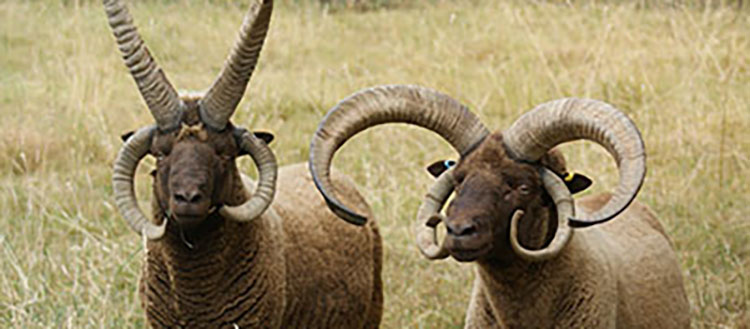Of multiple-horned goats and sheep
Scientists from the INRAE, ALLICE and UNIGE have discovered the genetic causes of the abnormal presence of an additional pair of horns in Bovids.

Bovidae with four horns. © John Hedges
Bovidae sometimes display supernumerary horns. For instance, local breeds of sheep genetically selected by generations of breeders, are known for their multiple horns, a condition referred to as ‘polyceraty’. It also happens, particularly in the Alps, that goats spontaneously develop an additional pair of horns. While the genetic causes of this morphological curiosity have long remained unknown, it seems that this mystery has now found its solution. Indeed, a genomic study of many such mutant animals, carried out by the French National Institute for Agricultural and Environmental Research (INRAE) and the union of breeding cooperatives ALLICE together with the University of Geneva (UNIGE), in collaboration with the EPFL and several other research centers distributed over four continents, reveals that all the four-horned goats and sheep analyzed carry a mutations affecting the same gene: HOXD1. Results to be read in the journal Molecular Biology and Evolution.
Evidence of the existence of these four-horned or ‘polycerate’ animals dates back several centuries, such as this four-horned goat whose transfer in 1786 from the town of Bulle in Switzerland to the Queen’s Hamlet at Versailles, at the wish of Queen Marie Antoinette, is duly recorded. However, the genetic causes of this morphological curiosity remained unknown for a long time. “We wanted to solve this mystery by analyzing the genomes of these particular animals,” explains Aurélien Capitan, from the INRAE and ALLICE institutes and co-responsible for this study with Denis Duboule, from the Department of Genetics and Evolution of the Faculty of Science at UNIGE.
A well-known culprit
Thanks to the collaboration of goat and sheep breeders, the geneticists were able to analyze a large number of genomes from specimens with four horns and found that they all had a mutations affecting exactly the same gene “We discovered that the gene responsible for the appearance of supernumerary horns was the HOXD1 gene,” says Aurélie Hintermann, a researcher at the Faculty of Science of UNIGE.
The latter gene is not unknown since it is an architect gene, one of the 39 Hox genes that construct the body plan during the development of embryos. The mutations are different in sheep and goats, but in both cases lead to a reduction in the amount of protein produced by this gene.
A gene that delimits the horn growth zone
In this particular case, it appears that the function of the HOXD1 gene is necessary to define the extent of a surface delimiting where horns can grow, on either side of the head. When this gene is mutated, the limits of this surface extend, resulting in the splitting of the horn buds during embryonic development and ultimately in the growth of supernumerary horns. “This is a new and unexpected function for an architect gene, a function that probably evolved specifically with the appearance of small ruminants, allowing them to define the precise place from which these organs so characteristic emerge as well as their number,” concludes Denis Duboule.
